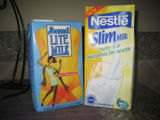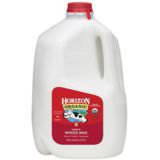Skim milk is produced by separating and removing the fat content from whole milk , and then fortifying it with vitamin D and vitamin A. The fat content of whole milk is around 3.5% while skim milk contains less than 0.2% fat. Lower fat content means skim milk has fewer calories and less cholesterol compared with whole milk. This is usually good for weight loss or for people with weak cardiovascular health. The American Association of Pediatrics recommends skim milk for kids over two, but a recent study has shown that children who drink skim milk tended to be heavier than those who drank whole milk.
Comparison chart
| Skim Milk | Whole Milk | |
|---|---|---|
 |
 |
|
| Fat (1 cup) | 0g | 8g |
| Calories (1 cup) | 86 | 146 |
| Saturated fat (1 cup) | 0g | 5g |
| Protein (1 cup) | 8g | 8g |
| Sugars (1 cup) | 12g | 13g |
| Cholesterol (1 cup) | 5mg | 24mg |
| Sodium (1 cup) | 127mg | 98mg |
| Calcium | 30% | 28% |
| Vitamin A (% daily value) | 0% | 5% |
| Vitamin C (% daily value) | 4% | 0% |

Nutrition
Calories
One cup of whole milk has close to 150 calories while one cup of skim milk contains about 90 calories. Removal of fat content from milk has a direct impact on the calorie count.
Calcium
Milk is a great source of calcium; whether it’s whole milk or skim milk, one cup provides 25-35% of one’s daily calcium requirement.
Fats
One cup of whole milk has 8g (grams) fat, 5g of which is saturated fat , which is considered risky for cardiovascular health , especially if saturated fat intake from other foods consumed during the day is high. Having said that, it is important to note that the body needs some saturated fat. e.g. for the production of hormones, the stabilization of cellular membranes, the padding around organs, and for energy.
Cholesterol
Much like fat, skim milk has lower cholesterol content than whole milk. One cup of whole milk contains about 24mg of cholesterol, while a similar sized serving of skim milk only has 5mg cholesterol.
Impact on health
Cardiovascular Health
Whole milk contains much more saturated fat – one cup contains 5 grams, a quarter of your daily intake. It is also high in cholesterol, at 25 mg per serving. As high intake of saturated fat and cholesterol can increase chances of strokes and heart attacks, people with a family history of high blood pressure , high cholesterol or other cardiovascular disorders should use skim milk. Elderly people should also drink skim to prevent cholesterol build up.
Diabetes
According to a study published in The Annals of Internal Medicine , those who eat high-fat dairy products, including whole milk, have about 60% lower risk of developing adult onset diabetes than those who drink skim milk.
Fertility
A study at Harvard in 2006 suggested that a high intake of skim milk can impair ovulation, while drinking whole fat milk can improve fertility. Those who are planning to get pregnant or are currently pregnant should stick to whole milk. [1]
Weight Loss
Skim milk contains significantly less calories and fat than whole milk and is fortified with extra protein, making it ideal for weight loss. However, the conjugated linoleic acid in whole milk may reduce body fat and increase lean muscle mass . Both types therefore have pros and cons, and can be included in weight loss plans, as long as people watch their calorie intake.
Recommendation for children
Since 2005, both the American Academy of Pediatrics (AAP) and the American Heart Association (AHA) recommended that children drink skim or low-fat milk after age two. However, a recent study published in the Archives of Disease in Childhood in early 2013 found that kids drinking skim milk tended to be heavier than kids drinking 1% or whole milk. The study did not control for genetic factors or other foods that the children ate, so while the results are interesting they are not necessarily conclusive. [2]
References
- Wikipedia: Milk
- Wikipedia: Skimmed milk
- Conflicting studies on milk – Boston.com
- Nutrition data for milk – Self Nutrition Data
- Skim Milk May Not Lower Obesity Risk Among Children – TIME
- A prospective study of dairy foods intake and anovulatory infertility – NIH.gov